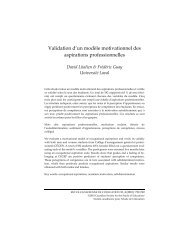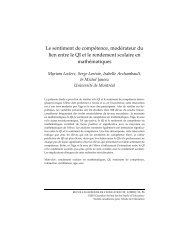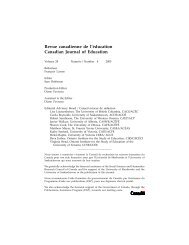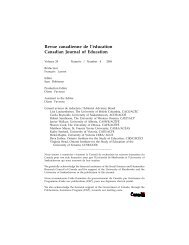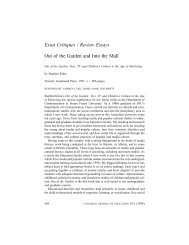Mireille Falardeau et Michel Loranger Le choix de stratégies ... - CSSE
Mireille Falardeau et Michel Loranger Le choix de stratégies ... - CSSE
Mireille Falardeau et Michel Loranger Le choix de stratégies ... - CSSE
Create successful ePaper yourself
Turn your PDF publications into a flip-book with our unique Google optimized e-Paper software.
ART, IMAGINATION, AND TEACHING 373<br />
gui<strong>de</strong>lines for research, given shared un<strong>de</strong>rstandings of participants operating<br />
un<strong>de</strong>r specialized professional circumstances. Observers are not measuring<br />
carefully structured discr<strong>et</strong>e acts. Rather, they interpr<strong>et</strong> events in the flow of life,<br />
make links, and grasp implications. In some situations, it may not be immediately<br />
clear, for example, what specific items of knowledge a teacher has used in<br />
making a motivating suggestion to a stu<strong>de</strong>nt. Judgements may som<strong>et</strong>imes have<br />
to be based on informed speculation rather than on fact.<br />
It should also be remembered that teaching is imaginative by <strong>de</strong>gree. We<br />
speak, for example, of particular actions or achievements as being highly imaginative<br />
or fairly imaginative, rather than as being or not being imaginative in<br />
some absolute sense. Despite such uncertainties, the point remains that to be<br />
<strong>de</strong>emed good, art teaching needs some imaginative elements over the long haul.<br />
One last note: I was not attempting to discover empirically wh<strong>et</strong>her good art<br />
teaching is imaginative in practice. For that six cases would hardly be convincing.<br />
The point has already been ma<strong>de</strong> that imagination and art teaching are<br />
conceptually linked. My intention was to show the reality of the i<strong>de</strong>al, that is, to<br />
show its diversity in practical experience for purposes of greater un<strong>de</strong>rstanding.<br />
In normative matters it is possible to learn from a small group of individuals, or<br />
even from a single excellent teacher.<br />
NEGOTIATION OF ENTRY<br />
I m<strong>et</strong> with the six researchers, who were volunteer graduate stu<strong>de</strong>nts, teacher<br />
education graduates, art teachers, and art education stu<strong>de</strong>nts, to clarify purposes,<br />
concepts, and m<strong>et</strong>hods. Successful high school art teachers, i<strong>de</strong>ntified by school<br />
district arts coordinators as being potentially willing participants, were approached<br />
informally and the six interested in the project were invited to a voluntary<br />
me<strong>et</strong>ing where the research was explained in d<strong>et</strong>ail and without obligation. Procedures<br />
followed the <strong>et</strong>hical requirements of the university. Researchers were<br />
paired with teachers on the basis of geographical convenience.<br />
THE RESEARCH QUESTIONS IN REVIEW<br />
1. Un<strong>de</strong>r what circumstances (material, social, architectural) does teaching and<br />
learning take place?<br />
In the broa<strong>de</strong>r m<strong>et</strong>ropolitan community the visual arts have a high profile<br />
through the various galleries, art and craft associations, community colleges, a<br />
college of art, and two universities. The six schools involved in the study are<br />
mo<strong>de</strong>rn, urban and suburban. The school populations vary in composition from<br />
white and middle-class to multi-racial and working-class. Pupil numbers range<br />
from 1,000 to 1,800. In one school, stu<strong>de</strong>nts speak 22 different home languages.<br />
Classroom arrangements for art are predominantly single-use special facilities.



